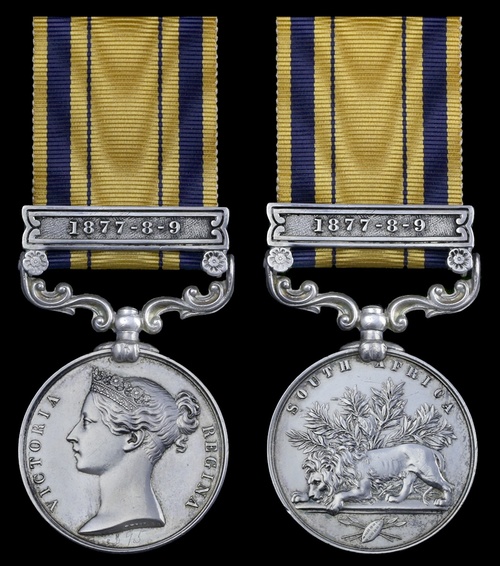Auction: 19002 - Orders, Decorations and Medals
Lot: 26
An interesting South Africa Medal awarded to Blacksmith's Mate S. Smith, Royal Navy, late Farrier Sergeant, Royal Artillery, who having been one of just two men of his unit to receive the Medal, had a long career afloat which included the passage of the Royalist through the Solomun and Gilbert Islands, a tour which included a number of retributional Bluejacket actions ashore
South Africa 1877-79, 1 clasp, 1877-8-9 (4389 Fr. Sergt. S. Smith. O/2. Bde. R.A.), very fine
Just 2 Medals issued to 'O' Battery, 2nd Brigade Royal Artillery, this unique with clasp.
Selah Smith was born at Great Houghton, Northampton on 21 January and served with the Royal Artillery in South Africa in the rank of Farrier Sergeant, with this Medal being issued on 18 July 1881. Having been promoted Shoeing Smith and living at Woolwich Barracks, Smith entered the Royal Navy on 29 July 1886, joining the Blacksmith's Crew. It was whilst in the Royalist on her journey to the South Pacific that Smith would have likely shared in the actions reported in the New York Times, 30 October 1891, under the title 'Cruise of the Royalist - Solomon Islands' Natives punished for their crimes':
'Letters received from the Solomon group of islands give particulars of the cruise of Her Majesty's ship Royalist among the islands, and the punishment inflicted by Captain Davis on the natives for outrages committed on British subjects. The vessel visited Rubiann and by a little stratgem Captain Davis secured the Chief, named Tooloo, from the villages. He is now a prisoner on board pending further inquiries.
Dobell was next visited. It was at this village that four boys belonging to the cutter Freak were massacred. Captain Davis sent a message to Chief Tono demanding that the murderers be handed over to him. Receiving no reply, he, much to the surprise of the natives, landed with a party of twenty five men and went to their village five or six miles inland, where Chief Tono was shot down.
The Chief, with several of his tribe, was observed prowling around the landing party and it was evident that the natives would have done further mischief had their leaders not been shot. The village was burned and before returning to the ship the men went along the coast about three miles and destroyed two war canoes.
The massacre of two natives belonging to the Sydney schooner Marshalls was reported to Captain Davis at the islands. They had been enticed away from their vessel and then killed. A Chief named Parango, who turned Queen's evidence in the Howard case, was brought on board the Royalist, but one night he suddenly disappeared, having, it is supposed, jumped overboard.
The Royalist is now at Cairns, but she is expected to return to the Solomon Islands to complete her work.'
During the tours of the Royalist, Captain (later Admiral) Edward Davis raised the British flag on 13 islands in the region. Besides enforcing and gaining colonial control, he also secured a plethora of ethnographical objects for future study - of nearly 1,500 objects some 141 of these items are now housed in the collection of the British Museum. One of them is a feast bowl captured in the Rubiana Lagoon, Solomon Islands. It had previously been used to serve the flesh of the bodies of captives from surrounding villages after successful raids.
Smith left Royalist in December 1893 and was promoted Blacksmith by 1899. He was finally shore pensioned in December 1904 and died at Bedwelty, Monmouthshire in 1930; sold with copied service record and research.
Subject to 20% VAT on Buyer’s Premium. For more information please view Terms and Conditions for Buyers.
Sold for
£1,700
Starting price
£320







